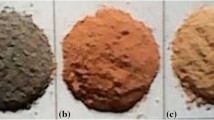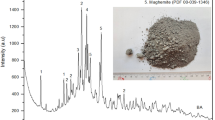Abstract
The aim of the present study is to produce novel developed composite materials which provide thermal insulation by using waste and natural materials in construction applications. Composite construction samples were prepared using an expanded perlite aggregate of 15 % wt., 30 % wt., and 45 % wt., which had the grain sizes of 0–3 mm, 3–5 mm and 5–8 mm, as well as waste marble dust of 5 % and 15 % filtrated from a 300 µm sieve, combined with molten tragacanth of 0 %, 0.5 % and 1 %, and CEMI 42.5 N-type portland cement. The microstructure of the composite samples was examined by the SEM analysis. Density, thermal conductivity, compressive strength, abrasion loss, water absorption, compressive strength after high temperature, and compressive strength after freeze–thaw tests were performed on these composite samples. It was found that the density values of composite materials decreased from 1.983 g·cm−3 to 0.933 g·cm−3. It was observed that their porosity ratios up to 43 % were improved by increasing the amount of waste marble dust, expanded perlite and molten tragacanth, additionally, while their compressive strengths decreased. Thermal conductivity of the porous samples decreased from 0.468 W·m−1·K−1 to 0.167 W·m−1·K−1 by raising their porosity, which corresponds to a reduction of 36%. It was observed that as the rates and sizes of the materials used in the samples, their thermal conductivity, compressive strength and density values decreased, and the abrasion loss and water absorption increased.











Similar content being viewed by others
Abbreviations
- AL:
-
Abrasion loss (%)
- avr:
-
Average
- c:
-
Cement
- d:
-
Dry
- ep:
-
Expanded perlite
- Md:
-
Marble dust
- t:
-
Tragacanth
- w:
-
Wet
- WA:
-
Water absorption (%)
- ρ:
-
Density (g·cm−3)
- Φ:
-
Porosity (%)
- 1:
-
Startup
- 2:
-
Finish
References
M. Záleská, M. Pavlikova, J. Pokorný, O. Jankovský, Z. Pavlík, R. Černý, Constr. Build. Mater. 180, 1 (2018)
C. Tasdemir, O. Sengul, M.A. Tasdemir, Energy Build. 151, 469 (2017)
M. Lanzón, P.A. García-Ruiz, Constr. Build. Mater. 22, 1798 (2008)
H. Shoukry, M.F. Kotkata, S.A. Abo-EL-Enein, M.S. Morsy, S.S. Shebl, Constr. Build. Mater. 102, 167 (2016)
H. Doğan, F. Şener, News Bull. 1, 51 (2004)
Y. E. Çiçek, Comparative examination of physical, chemical, and mechanical properties of terracotta, brick, pumice concrete, gas concrete and perlite construction materials, Phd. thesis. (ITU Institute of Science, Istanbul, 2002)
ETİ Holding Coorp, Perlit Mine Directorate. Istanbul Bull. 67, 37–38 (2003)
S. Azizi, Mechanical Properties and thermal insulation of perlite-doped lightweight concretes, Phd. thesis, (ITU Institute of Science, Istanbul, 2015)
K. Ayse, K.A.R. Filiz, Constr. Build. Mater. 105, 572 (2016)
M.J. Shannag, Constr. Build. Mater. 25, 658 (2011)
K.M.A. Hossain, M. Lachemi, ACI Mater. J. 103, 11 (2006)
K.M.A. Hossain, S. Ahmed, M. Lachemi, Constr. Build. Mater. 25, 1186 (2011)
H.A. Gavlighi, Tragacanth gum: structural composition, natural functionality and enzymatic conversion as source of potential prebiotic activity, PhD thesis, (Technical University of Denmark, Lyngby, 2012)
F. Koksal, O. Gencel, W. Brostow, H.H. Lobland, Mater. Res. Innov. 16, 7 (2012)
R.T. Hemmings, B.J. Cornelius, P. Yuran, Comparative study of lightweight aggregates. in Proceedings of the World of Coal Ash, (Lexington, 2009)
M. Sutcu, H. Alptekin, E. Erdogmus, Y. Er, O. Gencel, Constr. Build. Mater. 82, 1 (2015)
E.T. Tunc, J. Environ. Manag. 231, 86 (2019)
O. Soykan, C. Özel, The effect of marble dust grain size on properties of polymer concrete, (International Construction Congress, October 11-13, Isparta, 2012)
H.Y. Aruntaş, M. Gürü, M. Dayı, I. Tekin, Mater. Des. 31, 4039 (2010)
P. Türker, B. Erdoğan, F. Katnaş, A. Yağınobalı, Classification and properties of fly ashes in Turkey, (Publications of Turkish Cement Manufacturers’ Association, 2003), pp. 76–77
O. Sengül, S. Azizi, F. Karaosmanoglu, M.A. Tasdemir, Energy Build. 43, 671 (2011)
R. Demirboğa, R. Gül, Energy Build. 35, 1155 (2003)
D. Shastri, H.S. Kim, Constr. Build. Mater. 60, 1 (2014)
R. Demirboğa, R. Gül, Cem. Concr. Res. 33, 723 (2003)
Y. Bicer, S. Yılmaz, Eng. Technol. 7, 24 (2013)
F. Kocyigit, Evaluation of pumice and cement mixture with tragacanth as a new building material, PhD Thesis, (Fırat University, Elazığ, 2012)
Bergama Minning Perlite Factory Trade Corporation, http://www.bergamaperlite.com/. Accessed 21 Nov 2019
Dimer Marble and Mine Factory Trade Corporation, http://www.dimer.com.tr/. Accessed 15 Oct 2019
ASTM C1113/C1113M-09, Test method for thermal conductivity of refractories by hot wire (Platinum Resistance Thermometer Technique, 2013)
E.K. Akpinar, F. Koçyigit, J. Adhes. Sci. Technol. 30, 534 (2016)
J. Wyrwal, A. Marynowicz, J. Swirska, Bauphysik 30, 431 (2008)
T. Kavas, Production of refractory cement by using waste marble and aluminum hydroxide, PhD Thesis (Osmangazi University Institute of Science, Eskisehir, 2003)
ASTM C 666-92, Standard test method for resistance of concrete to rapid freezing and thawing, vol. 04.02 (Concrete and Aggregates, American Society for Testing and Materials, 1999)
Z. Huang, J.R. Liew, W. Li, Constr. Build. Mater. 148, 579 (2017)
X. Luo, W. Sun, S.Y.N. Chan, Cem. Concr. Res. 30, 379 (2000)
M.B. Karakoç, Constr. Build. Mater. 41, 21 (2013)
Author information
Authors and Affiliations
Corresponding author
Ethics declarations
Conflict of interest
The author declares no conflict of interests.
Additional information
Publisher's Note
Springer Nature remains neutral with regard to jurisdictional claims in published maps and institutional affiliations.
Rights and permissions
About this article
Cite this article
Koçyiğit, F. Investigation of Thermal and Strength Properties of a Novel Composite Developed for Insulation as Building Material. Int J Thermophys 41, 41 (2020). https://doi.org/10.1007/s10765-020-2620-3
Received:
Accepted:
Published:
DOI: https://doi.org/10.1007/s10765-020-2620-3




